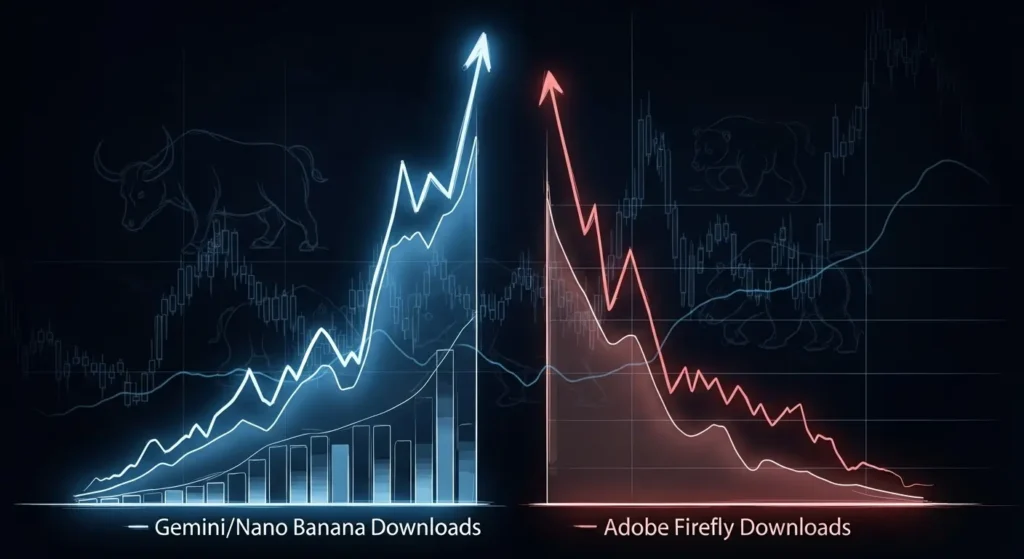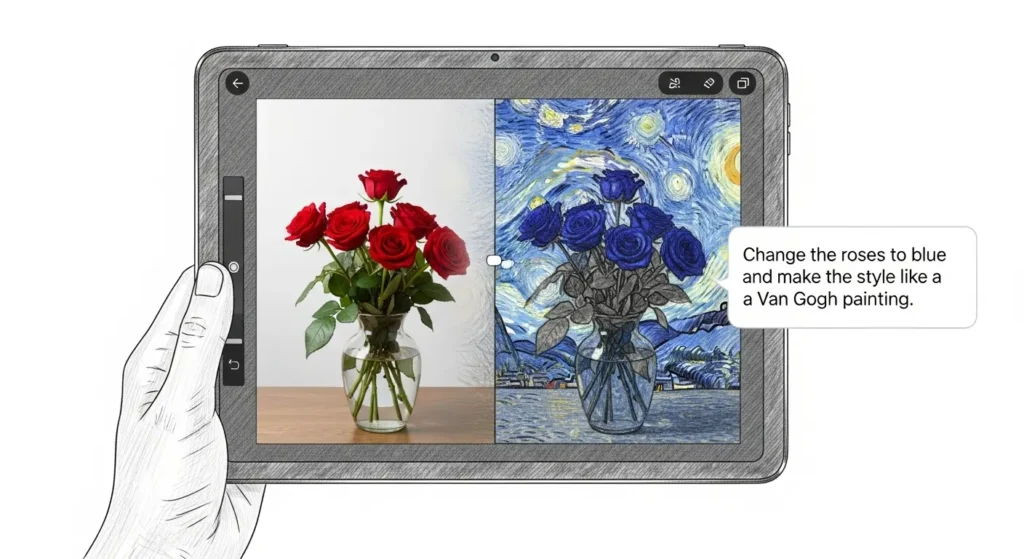Google’s new AI image editor, Nano Banana, has seen a 331% surge in downloads as Adobe Firefly plummets. Discover how its revolutionary features are changing the game.
Google’s Nano Banana has officially revolutionized artificial intelligence image editing.
The tool, launched by Google DeepMind in August 2025, has generated over 5 billion images and is now expanding across multiple platforms.
Table of Contents
Google (Nano Banana) DeepMind Unveils Revolutionary Tool
Nano Banana represents a codename for Gemini 2.5 Flash Image, Google’s state-of-the-art image generation and editing model.
The technology enables users to transform photos using natural language prompts, eliminating complex design software requirements.
The tool debuted with unprecedented capabilities. Users can edit images conversationally, blend multiple photos seamlessly, and maintain character consistency across different scenes.
Character Consistency Breakthrough

One standout feature distinguishes Nano Banana from competitors.
The model excels at maintaining character consistency, achieving a 95% success rate compared to previous models’ 70% performance.
This advancement allows creators to modify outfits, poses, and backgrounds while preserving facial features and identity.
The technology addresses a critical pain point that plagued earlier AI image generators.
Expansion Across Google Ecosystem
Google announced Nano Banana’s integration into multiple products in October 2025.
The tool now powers Google Search via Lens, enabling instant photo transformations through AI Mode.
Users can snap photos or select gallery images, then access Create mode for immediate AI-powered edits.
The feature rolled out in English across the United States and India, with additional countries planned.
NotebookLM received Nano Banana integration for Video Overviews.
The tool generates contextual illustrations, adds six artistic styles including watercolor and anime, and powers a Brief format for quick insights.
Google Photos will receive Nano Banana capabilities in coming weeks.
Market Impact on Adobe

Data reveals significant competitive implications.
Following Nano Banana’s August launch, Adobe Firefly downloads plummeted 68% while Gemini app downloads surged 331% by October 6.
According to BussinesInsider Analytics company Appfigures tracked dramatic shifts.
Gemini gained 6.1 million additional downloads compared to pre-Nano Banana weeks, while Firefly lost approximately 2 million downloads.
United States market data showed even starker contrasts. Gemini downloads jumped 88% between late September and October, while Firefly declined 82% during the same period.
Adobe’s stock reflected these challenges, dropping nearly 35% over the past year amid mounting competition from Google and OpenAI.
Advanced Editing Capabilities

Nano Banana processes images through conversational editing. Users describe desired changes using natural language, and the AI executes transformations instantly.
The model supports ten different aspect ratios, enabling content creation across diverse formats from cinematic landscapes to vertical social media posts.
Three quality tiers—Fast, Pro, and Ultra—offer flexibility based on project requirements and complexity.
Design mixing allows style transfer between images.
Users can apply patterns, textures, or visual characteristics from one photo to another, creating cohesive visual narratives.
Pricing Structure
Gemini 2.5 Flash Image operates on token-based pricing.
Each generated or edited image consumes approximately 1,290 tokens, costing roughly $0.039 per image.
The full rate stands at $30 per million tokens, with predictable costs regardless of whether users generate new images or edit existing ones.
Professional Applications

Small businesses have embraced Nano Banana for marketing materials.
The tool eliminates traditional photography and design costs, enabling entrepreneurs to create product photos, social media content, and promotional graphics.
Character consistency features prove valuable for content creators building AI influencers and user-generated content campaigns.
The technology maintains perfect face details across multiple edits.
Also See- New Ai Rules
Technical Specifications
The model includes invisible SynthID digital watermarking, ensuring AI-generated or edited images remain identifiable.
A visible watermark also appears on outputs.
Gemini 2.5 Flash Image maintains a knowledge cutoff date of January 2025, providing current information for contextual image generation.
Future Developments
Google continues improving long-form text rendering, character consistency reliability, and factual representation of fine details.
The company actively solicits developer feedback through forums and social platforms.
Integration across additional Google products signals the company’s commitment to democratizing visual creativity.
The technology transforms image editing from specialized skill to accessible capability.
Industry Response
Over 85% of professionals using AI image editing tools emphasize character consistency importance for delivering high-quality visual content.
Nano Banana addresses this priority directly.
Community insights suggest best practices. Users report 40% improvement in consistency when meticulously outlining anchor traits like eye color and hairstyle in initial prompts.
The tool’s success demonstrates demand for intuitive AI-powered creative tools.
By embedding capabilities into existing communication infrastructure rather than requiring specialized software, Google accelerates adoption.